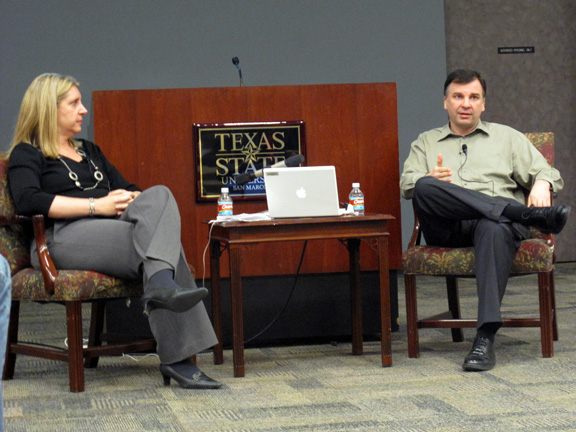Big News in Media
Wow. Lots going on these days. You’ve probably heard all about the changes at New York Times, with executive editor Jill Abramson being fired and associate managing editor Aron Pilhofer (a personal friend and inspiration) leaving to become executive editor of digital at the Guardian in London. This also happened around the time a big Innovation Report on The Times was leaked.
I am extremely happy for Aron, even though it means he’s leaving the US and NYT. He’s been instrumental in influencing my thinking around digital curriculum, and he’s been an advocate and adviser to many of my students. He let me hang out with his team and do a research project with them in 2009, studying the then new role of programmer-journalist. It was one of the best weeks of my professional life, learning from these smart people. I am excited for him about this big new role he will be playing in driving innovation at The Guardian and can think of no one more deserving.
I’ve been somewhat quiet about Jill Abramson’s firing. There were so many reports flying around last week, and we will probably never know the exact reasons for her departure. It was handled poorly, with lots of bad feelings for those involved, those working at NYT and readers. I greatly admire what Jill has done at NYT, and I can’t help but feel that some level of sexism is involved when any woman is portrayed as pushy or aggressive. She got to where she was because she had the right mindset for a media leader. And I know she was supportive of their digital efforts. We’ll see where things go from here.
For the Innovation Report, that’s pretty meaty. Publisher Arthur Sulzberger’s son Arthur Gregg Sulzberger led the team that did the analysis. It is critical of the overall efforts of The Times to move forward in the digital age. The report itself mentions pockets of innovation around the company, like the Interactive News team that Pilhofer led, but like many other news orgs, finds that the overall organization is in an Innovator’s Dilemma. That’s the phrase popularized by Clay Christensen that’s seen as any organization’s inability to be innovative if they must continue to tend to legacy businesses. The report is adept at mentioning new competitors, like Buzzfeed and Vox Media, which is consistent with my recent Nieman Lab article imploring media organizations to realize that they are now technology companies. Page 11 of the report is a full page of logos of new competitors in the digital media space.
There are several imperatives in the report, growing the audience, strengthening the newsroom and mapping a digital-first strategy. It makes a strong case for a better understanding of engaging the audience via social media. It discusses a range of different projects and products that The Times has developed that are strong examples of effective digital strategy. There are good recommendations, albeit a bit vague. Clearly, Sulzberger the Younger gets the digital media environment. This report is right on, in my opinion. My thought is that if The New York Times is having trouble moving quickly enough into digital, there’s no hope for anyone else.
Another report that looked at the move to digital for other organizations was put out by the Duke Reporters’ Lab, with the odd name, The Goat Must Be Fed. It shows an industry still clinging to old approaches and methods with little technical understanding or incentive for change. Dire. Both these reports will be required readings in my classes.
Toward the end of the NYT report, there were some great nuggets that I think relate to journalism education, where it discusses hiring. These comments are the areas onto which we need to be focused when we redesign curriculum to meet these needs.
- “The newsroom should think about our hiring needs — including jobs we need to create — for the next five to 10 years.” I’ve talked frequently about preparing students for jobs that don’t exist yet.
- “Our current approach overvalues journalistic skills for digital hires and undervalues digital skills for journalism hires — often because that reflects how most editors know how to evaluate talent.”
- “…we must change our mindset from hiring people ‘to continue the legacy we’ve established’ to hiring people ‘to shake things up.'”
- “We need more reporters and editors with an intuitive sense of how to write for the web, an interest in experimenting with mobile and social storytelling, a proficiency with data, a desire to engage with readers on and off our site, and a nuanced understanding of the shifting competitive landscape.”
These reports say a few things to me. First, in order to be innovative, we can’t just listen to the industry. It’s pretty clear that there are only pockets within organizations that understand the future of digital.
Second, we have a long way to go in developing curriculum that speaks to these issues. There are new competitors, some of which will be places our students will want to work. There are new processes and workflows. There are new tools and methods of storytelling. So, being a good writer isn’t enough. It’s the baseline, the minimum skill for entry. Students need judgment, critical abilities and an innovative nature. They need to be allowed to be creative. They need to be fearless in trying new things. And they need to realize that this is the world into which they are graduating.
Third, we don’t have time to wait. Just as news orgs need to recognize the need for change, so does journalism curriculum.
My hope is that we, as a discipline, can take these reports to heart and make real, meaningful and swift progress.
